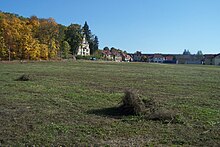Worsted yarn spinning mill in Wernshausen
The Kammgarnspinnerei Wernshausen , actually a company in Niederschmalkalden at Zwick was a member of the textile industry in the current Schmalkaldener district Wernshausen at the confluence of Werra and Schmalkalde in southwestern Thuringia .
Foundation and expansion
The worsted yarn spinning mill was founded in 1834 in Niederschmalkalden. The owner Johann Christian Weiß expanded his very successful worsted yarn business, which he had been running in Bad Langensalza since 1819/20.
The first company apartments were built in 1865. From 1920 onwards the company premises began to be expanded. Factory buildings and an administration building, designed by Karl Behlert , were added and finally formed the industrial face on the Zwick, an intersection of federal road 19 and state road 1026 to Schmalkalden.
Later up to 1,000 people worked here. There was a change to man-made fibers.
Decline
After the worsted spinning mill was initially closed in 1992 as a result of the strong market and competitive pressure, Wagenfelder Spinnereien GmbH (Gebr. Körner) acquired the company, now known as Hattdorfer Kammgarnspinnereien GmbH, Niederschmalkalden , based in Hattorf. At the same time, the so-called Behlert building, the administration building, was pulled empty.
At the historical location, the main buildings were largely refurbished after the fall of the Berlin Wall (GDR) or were further refurbished with funding.
From 2003 at the latest, the district administrator and mayor tried to prevent the closure of the Niederschmalkalder plant. The efforts failed. In 2004 production was relocated to the Czech Republic, and there were no successors.
particularities
The ensemble represented a unique industrial monument in southern Thuringia. They have been under monument protection since 2002 . The administration building with entrance loggia and largely original furnishings ( lead glass windows with motifs of wool processing, frescoes in the foyer, wood paneling and stucco ceilings) as well as the spinning mill building with over 15,000 m³ of usable space on five floors were of particular cultural value . Today the site is owned by the city of Schmalkalden (after incorporation of Wernshausen on December 1, 2008).
The decision to demolish was made by the former mayor of Wernshausen, Rainer Stoffel, with the support of District Administrator Ralf Luther (CDU) and the Thuringian state government and has been implemented since mid-January 2009. Opponents of the demolition were mainly Jochen Halbig and the Freundeskreis Todenwarth eV , the Schmalkalden museum director Kai Lehmann and various intellectuals, the Thuringian State Office for Monument Preservation and Archeology and the Left Party faction in the Thuringian state parliament . Above all, it was criticized that a nationally important industrial building monument is being demolished without absolute necessity and financed to around 90% from tax revenues. The Left Party was of the opinion that with the funding of 3.6 million euros, the monument could have been secured just as well and thus could have been preserved, especially because there is no evidence of any subsequent use for the terrain, which makes the demolition very necessary Question asked. It is unclear whether objects worth preserving such as the lead glass windows of the administration building have been secured.
As the last essential building, the building was blown up on August 1st, 2009.
The site has been fully developed since June 2010.
literature
- Thuringian State Archive Meiningen (Ed.), Norbert Moczarski et al .: Thuringian State Archive Meiningen. Department of the Regional Economic Archives of Southern Thuringia in Suhl. A brief inventory overview. Druckhaus Offizin, Hildburghausen 1994, pp. 16-24. (Chapter Development of Traditional Industrial Areas in Southern Thuringia until 1990 )
- Dehio-Handbuch der Deutschen Kunstdenkmäler, Thuringia. Deutscher Kunstverlag, Munich / Berlin 2003, ISBN 3-422-03095-6 .
Web links
- Marco Schreiber: The demolition company is already at work ( Memento from August 6, 2009 in the Internet Archive ). In: Free Word of January 21, 2009 (Internet Memento)
- What stands for a long time slowly perishes ( Memento from May 5, 2010 in the Internet Archive ). In: Free Word of February 12, 2009 (Internet Memento)
- Jan Schrenke: Vandalism in the Bauhaus year
- Press release from the Left Party member of the state parliament, Birgit Klaubert: No total demolition of the worsted yarn spinning mill in Wernshausen
- Video of the demolition of the worsted spinning mill in Wernshausen on August 1st, 2009
Coordinates: 50 ° 43 ′ 6 ″ N , 10 ° 21 ′ 49 ″ E

